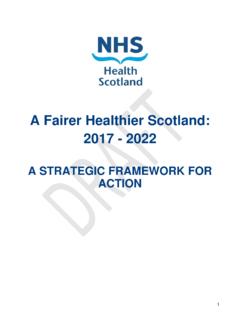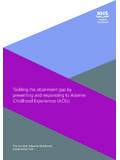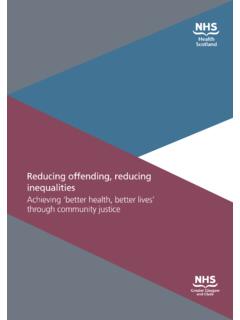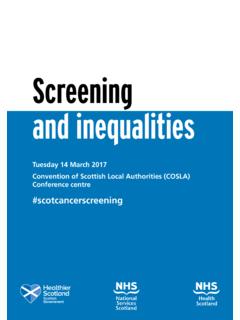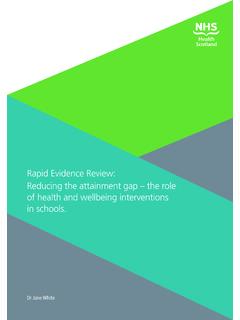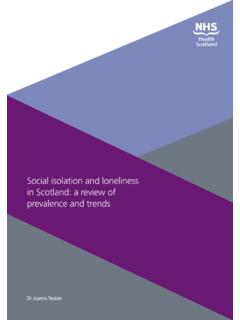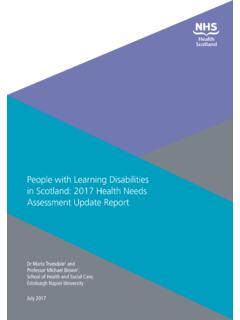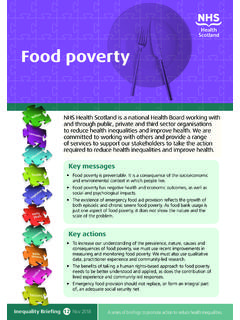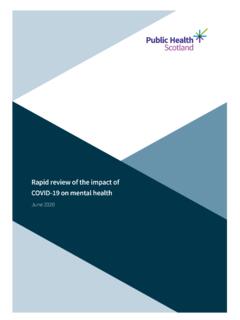Transcription of 1. Child Poverty (Scotland) Act 2017 - NHS Health Scotland
1 1. Child Poverty ( Scotland ) Act 2017 :an overviewPublished by NHS Health Scotland1 South Gyle CrescentEdinburgh EH12 9EB NHS Health Scotland 2018 All rights reserved. Material contained in this publication may not be reproduced in whole or part without prior permission of NHS Health Scotland (or other copyright owners).While every effort is made to ensure that the information given here is accurate, no legal responsibility is accepted for any errors, omissions or misleading Health Scotland is a WHO Collaborating Centre for Health Promotion and Public Health resource may also be made available on request in the following formats: 0131 314 5300 Poverty ( Scotland ) Act 2017 In 2015 the UK Government decided to remove the four Child Poverty income targets from its legislation.
2 The Scottish Government opted out of the revised UK approach and introduced its own income targets for Child Poverty reduction. These are written into legislation under the new Child Poverty ( Scotland ) Act the Child Poverty Act 2010, both the UK and Scottish Government were legally required to take action to substantially reduce Child Poverty . However, in July 2015, the UK Government announced its intention to repeal the four income-based targets for Child Poverty contained in the UK Child Poverty Act 2010 via what eventually became the Welfare Reform and Work Act 2016.
3 In response to the UK Government s intention, Scottish Ministers secured an opt-out in the 2016 Act by repealing all parts of the 2010 Act that imposed any duty on the Scottish Ministers. The Scottish Parliament passed a legislative consent motion approving the provisions which formed the The Scottish Government proposed the Child Poverty Bill with the purpose of enshrining in legislation an ambition to eradicate Child Poverty in Scotland , underpinned by the reinstatement of statutory income targets, against which our progress could be judged.
4 The Bill for this Act of the Scottish Parliament was introduced on 9 February 2017 , passed by the Parliament on 8 November 2017 and received Royal Assent on 18 December introduce a Child Poverty Act? Child Poverty can have negative effects on the Health , wellbeing and educational attainment of the children who experience it. It also has a wider cost for society (see briefing 2 Child Poverty in Scotland : scale, trends and distribution). By introducing a Child Poverty Act, which sets out clear targets for reducing the number of children living in Poverty , progress can be monitored on meeting these Child Poverty ( Scotland ) Act 2017 sets out four ambitious headline targets for 2030 that establish Scotland as the only part of the UK with statutory income targets on Child 2 The Child Poverty ( Scotland ) Act 2017 The Act sets out: Four statutory income targets, to be met in the financial year beginning 1 April 2030.
5 Four interim income targets, to be met in the financial year beginning 1 April 2023. A statutory Poverty and Inequality Commission will be established from 1 July 2019, with functions related to the Child Poverty reduction targets. The Act also states: Scottish Ministers must publish Child Poverty delivery plans in 2018, 2022, and 2026, and report on those plans annually. Local authorities and Health boards must report jointly every year on activity they are taking, and will take, to reduce Child Statutory income targets for 2030 Measuring Poverty is complex and unlikely to be accurately captured in a single measure.
6 Therefore a suite of four measures were developed for the Act based on a relative income measure, a fixed income measure, a material deprivation measure and a persistent Poverty measure. In addition, the Scottish Government made the decision that the new statutory targets for Scotland would be measured on an after housing costs (AHC) basis rather than before housing costs (BHC), which the UK targets are based approach is consistent with the academic consensus on Child Poverty , which strongly supports retaining the 2010 Child Poverty Act indicators in legislation and is nearly unanimous in retaining income as a measure of Child Poverty measurement.
7 Poverty is understood primarily to be a relative lack of material resources, with income widely believed to be the best proxy measure .4 The four targets in the Act for 2030 therefore seek to address the following four measures of Poverty (see SPICe Briefing 2017 for more definitions of terminology). The targets are to be met in the financial year commencing 1 April 2030 and include: Relative Poverty : a Child is in relative Poverty if they live in a household where equivalised income for the financial year in question is less than 60 per cent of the median equivalised net income for that financial : Less than 10 per cent of children live in households that are in relative Poverty .
8 Target: Less than 5 per cent of children live in households that are in persistent Absolute Poverty : a Child is in absolute Poverty if they live in a household with an income below 60 per cent of the median equivalised net income in 2010 : Less than 5 per cent of children live in households that are in absolute Poverty . Combined low income and material deprivation: a Child is in combined low income and material deprivation if they live in a household with an income below 70 per cent of the equivalised median net income for that year and are unable to afford a number of basic goods and services (material deprivation).
9 Target: Less than 5 per cent of children live in households that are in combined low income and material deprivation. Persistent Poverty : a Child is in persistent Poverty if they have been living in Scotland and in relative Poverty for three of the past four partners working to tackle Poverty in Scotland are already familiar with these four measures. Keeping them provides a degree of continuity with measures previously set out in the UK-wide Child Poverty Act 2010. All four measures were chosen following extensive UK-wide consultation and were designed to complement each other, with each capturing different aspects of required to meet targetsBelow we compare current levels of Poverty across the four indicators with the 2030 targets.
10 Current level in2016/17 Relative Poverty 23 18 Absolute Poverty 20 14 11 8 Persistent (AHC) 10 (2012 16) 8 Relative and Material deprivationInterim target by2023/24 Final target by2030 Percentage of children experiencing the four measures of poverty105555 Poverty and Inequality CommissionThe Scottish Government s Fairer Scotland Action Plan included a commitment to set up an independent non-statutory Poverty and Inequality In July 2017 , the Commission was established to offer independent advice to Ministers, and provide scrutiny to help bring about real reductions in Poverty and inequality in Scotland .
